HK Spring Lighting Show Surprising Success for Many First-time Exhibitors
2009/06/05 | By Ken LiuThe Hong Kong Trade Development Council (HKTDC), Hong Kong's leading trade-fair organizer, took a chance amid the global downturn to lend more specialization to the Hong Kong Electronics Fair (spring edition) 2009 and International ICT Expo 2009, by setting aside a hall in the Hong Kong Convention and Exhibition Center specially for the first spring edition of the Hong Kong International Lighting Fair 2009, held April 13 through 16. The original goal to attract 300 exhibitors could not be met, with only 235 exhibitors taking part. And some commented that the fair is too small relative to the autumn edition.
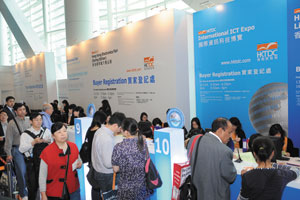
However, many first-time exhibitors collected sizable numbers of business cards on the first day alone, a pleasant boost of confidence.
Also the HKTDC made sourcing easier for lighting product buyers, sparing them from having to wade through a sea of electronic items displayed at the same venue.
"This spring lighting fair is held in response to buyers' requests asking for another lighting fair besides the autumn show in Hong Kong, for the gap between the two is too long to keep their shelves filled," said Janic Yuen, an HKTDC manager promoting the lighitng fair.
Like the autumn editions, the spring lighting fair highlighted energy-saving lights, notably LED lamps, as well as covering crystal lighting, green lighting, holiday lighitng, outdoor lighting, lighting accessories and components, and table lamps. The exhibitors mostly were from China, Hong Kong and Taiwan. The China Economic News Service (CENS), besides circulating magazines, organized the Taiwanese exhibitor delegation under HKTDC authorization.
Few western exhibitors took part, partly because of an upcoming lighting fair in Milan that would have added to costs to attend the Hong Kong show.
Showing Confidence
Many suppliers from outside Greater China are convinced by the HK lighting show. MSeedTech Co., Ltd. of South Korea was one such exhibitor who attended the Hong Kong lighting fair the second time after taking part in the 2008 autumn fair. "The Hong Kong lighting show is the world's second largest and we plan to be here every year to tap overseas markets. Our products are good quality while competitively priced for developed economies," said a sales representative.
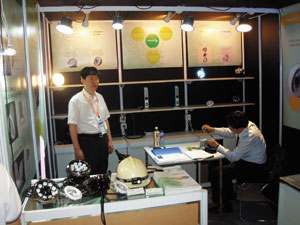
MSeedTech's multilayer thin-coating technology makes its LED lamps unique, according to the sales rep., so much so that Osram is offering its LED emitters in a partnership to have MseedTech produce light-modules.
"Our patented coating technology is mostly used in the semiconductor-equipment industry for its good anti-erosion and waterproof quality," said the rep.
MSeedTech promoted a variety of LED lights at the show, including underwater lights, underground lights, fountain lights, table lamp, sensor light, MR16, downlight, and light bulbs, many of which use AC LEDs.
"AC LED is very convenient for household consumers, as well as eliminating extra components like DC adapters. Such LEDs will achieve high demand once prices drop and mass production begins," he said.
The representative noted that the global financial crisis, compounded by the high price of LEDs, is pushing MSeedTech to enter the LED-lighting market by first aiming at commercial and government lighting projects. "The South Korean government offers 50% subsidies to enterprises using energy-saving lighting products like LED lamps, as well as implements sizable LED lighting projects," he added.
Going Global
Also a first-time exhibitor, Interform Inc. of Japan displayed household lighting fixtures to draw overseas orders. "It's about time for us to export products worldwide as the Japanese economy is rocky and domestic lighting market is small," said sales representative Kenji Fujiwara.
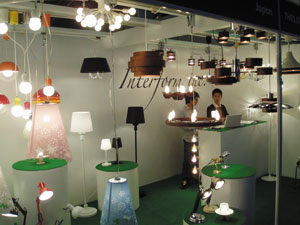
Interform showed mostly desktop lights, floor lights and pendants-which can adopt incandescent or compact fluorescent lamps. "This show for us is not about lamps but lighting fixture design," stressed Fujiwara. One of the newcomer's speciality is laser-cut motifs on lampshades and wooden body.
Although competing internationally as a design-oriented lighting maker is an uphill battle, Interform seemed brimming with confidence: "We have five excellent designers, who work hard to create new and different items. We introduce 30 new designs every quarter, and release catalogs twice a year," Fujiwara emphasized.
Despite the downturn having sapped spending power, Fujiwara believes new, well-designed products can bring in customers: "You have to be aggressive to stimulate demand during hard times with new products featuring good design."
Also Interform is savvy enough to, besides emphasizing design, to keep prices competitive by making products in China because cost is quite high in Japan, he said.
Brilliant Technology
One exhibitor who boasted considerable tech advantage at the Hong Kong show was LedEngine, Inc. of the United States. The company promoted its LuxDot MR16 LED lamps, which reportedly uses a phosphor-free LED lighting technology. "No phosphor, no worry about phosphor-plaguing problem. That makes our products last longer than rivals'," said Robin Hung, the company's Asia Sales Director.
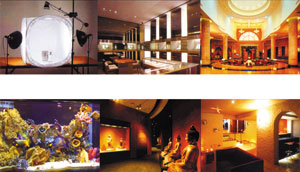
LuxDot, according to Hung, is developed to replace 35W halogen MR16 lamp, boasting 80% energy savings and 10 times longer lifespan than the halogen cousin. LuxDot easily plugs into standard MR16 fixtures, making it ideal for museums, hotels, restaurants, retail stores, and many other venues.
"Most of all, LuxDot delivers targeted, quality light beam which we call 'Lux on Target'. The beam is so even that the lit area shows no dots," Hung said.
Another notable feature is the LED MR16 lamp's chip that enables delivery of color temperatures ranging from 2800K to 5500K (warm white light is 2800K-3100K), making it suitable for wide-ranging applications. "LuxDot offers the quality and quantity of light ideal for spot, accent, track and down lighting applications with a narrow beam pattern," Hung noted.
Luxdot, Hung said, comes in AC and DC versions, is dimmable, has 90%-plus power factor, and complies with RoHS regulations. "These features are already seen in many dominant lighting products. This means we are determined to make LED a day-to-day lighting product."
Regarding the impact from the global downturn, the impact to end-user markets is obvious but moderate to commercial markets, said Hung. "That's because enterprises are eager to replace energy-guzzling lights with energy-saving lamps like LEDs to minimize maintenance costs and electrical bills. Household users are still put off by costly LEDs even during hard times."
Swedish Market Stays Bright
Fredrik Bohman, merchandising manager of Jula Postorder AB of Sweden, was at the Hong Kong show to source new items and suppliers of lighting and electronic products. The company sells wide-ranging products in Sweden, including tools, electric items, gardening tools and lighting products.
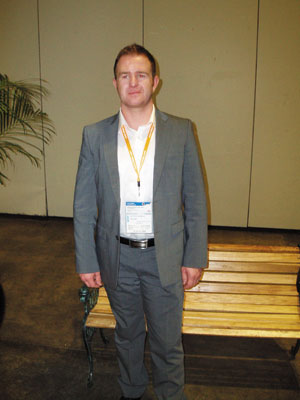
Sweden is still a pretty good market for Jula Postorder AB regardless of the global recession, according to Bohman. "We have a range of good quality products at competitive prices. In recessions, consumers usually choose competitive products. So, we still have good sales," he said.
Similar to many industrially advanced economies, LED is becoming a trendy lighting product in Sweden. "Sweden is increasingly focused on energy-saving lights like LEDs, which would be a focus in coming years, I think," Bohman observed.
The European Union's (EU's) decision to begin reducing incandescent bulbs in September this year, Bohman said, would drive consumers in the EU to use energy-saving lights. "The EU will gradually rid of incandescent bulbs from the market through 2012 to reduce power used in lighting," he said.
Bohman felt the spring lighting show is much smaller than the autumn edition, which he visited the first time last year. "The autumn show offers a wide range of products and suppliers," he stressed, saying that he would revisit the spring show next year.
Sourcing LEDs Only
Rockey Ivey, managing director of the Australian LED-lighting importer Colourbright Pty Ltd., was searching for new LED lights only. "LED is a new lighting technology. And I believe compact fluorescents will be phases out and everything will be LED soon," he said.
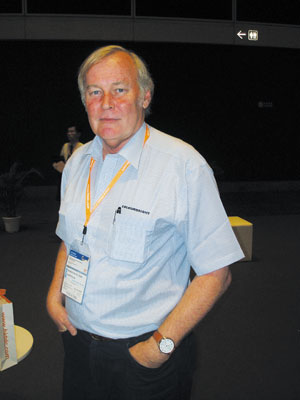
As LED prices are still high relative to traditional lighting prices, Australians, Ivey noted, have begun accepting LED lights only for commercial and industrial applications. "Durable LED lights are accepted because lamp replacement is very expensive in Australia. You don't want lights in high places to be replaced frequently," he stressed.
Incentives offered by the Australian government to reduce electricity consumption, Ivey said, is drawing commercial and industrial sectors to go LED.
Colourbright has added solar technology to its streetlight. "I just put solar on streetlight not just for official incentives but also for solar streetlights cost nothing to run," Ivey stressed.
Registering growing sales, Ivey did not think the global recession had taken a toll on the Australian lighting market. "I believe my sales will increase annually by 50%. I'm a small business, so I just do as my competitors, trying to win every single sale," he said.
As a supplier of LED traffic lights, arrow boards, message signs, trailers, and trailer parts and accessories, Ivey said his segment does not have any trendy designs. "Most of my sales are converting existing lights to LEDs. All we do is replace halogens or compact fluorescents with LEDs to save energy," he explained.
Ivey used to source goods from Taiwan. Now he buys from China after discovering many Taiwanese manufacturers actually make products in China. "The quality of Chinese products has gone up rapidly over the past years," he observed.
Bold Move
Instead of diversifying into LED as many lighting retailers, David J. Weiss, a U.S. retailer of LED lighting products, directly jumped into the LED lighting business nine years ago upon setting up his own shop. He visited the Hong Kong lighting show to search for LED lights. Justifying his move to venture into LED lighting at the outset, he said: "American consumers do not know how to dispose of burnt fluorescent lamps and its mercury waste as the States has no recycling system for such lamps."
One of Weiss' major product lines is LED Christmas lights, which has become his barometer for measuring the American lighting market. "Last Christmas we saw few people decorating houses with lights nor buying lights as in the past. That meant they didn't want to spend money or pay more for electrical bills," he said, adding that people will replace a burnt 100-watt bulb with a 70W LED or compact fluorescent, simply to have a lower electrical bill.
Believing solar energy has good potential as an energy-saver, Weiss said: "Because people can do some fun things with solar and solar gear is now much cheaper, plus solar is free electricity."
In spite of some signs showing a slowdown in the recession, Weiss does not think the U.S. lighting market will rebound to its original after seeing last Christmas, saying that putting up Christmas lighting is a huge hassle. The recession may have jolted Americans out of the tradition of decorating with Christmas lights. Many years may pass before Americans return to the habit of putting up festive lighting.
The recession, however, may bring new opportunity for the daily lighting market, Weiss thought. "People need lights regardless of recession. They may not take vacations, go to movies, or dine out as often. But that means more lights are turned on for they spend more time at home."
Expanding Range
Vadim Senechkin, purchasing manager of Compact-Optima Ltd. of Russia, was sourcing new items at the Hong Kong show to expand the company's product range to prop up sales amid the recession, which he said pushed down sales at an annual rate of 30% last year alone. "We are searching for new products like household lights and fluorescents at this show," he said.
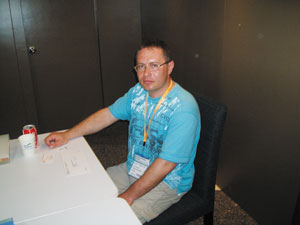
Senechkin said his company has been sourcing in Asia more frequently than before. "Especially when the world economy is changing very fast now; freight has become very cheap, only around half the previous US$10,000 per container. Also Asian products have become cheaper because Asian currencies fluctuate against the U.S. dollar. It's very good for us to shop here," he explained.
Compact-Optima purchases mostly in China because products there are very cheap. "Russian consumers are not inclined to accept high-priced products," Senechkin added.
The company, according to Senechkin, specializes in streetlights, waterproof lamps, and floodlights, among others, none of which are LEDs. "LED is not yet popular in Russia because it is expensive," he said, adding that LED is to emerge as a trend in Russia in a few years.
The Russian government, Senechkin noted, promotes using energy-saving lamps, which are limited to homemade lamps by imposing high tariffs on imported products. "So, imports are very expensive in Russia now," he said.

